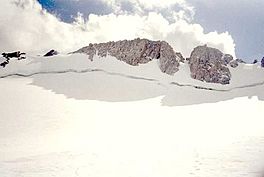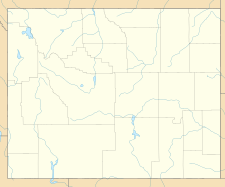Upper Fremont Glacier facts for kids
Quick facts for kids Upper Fremont Glacier |
|
|---|---|

Upper Fremont Glacier on the north ridge of Fremont Peak
|
|
| Type | Mountain glacier |
| Coordinates | 43°07′52″N 109°36′58″W / 43.13111°N 109.61611°W |
| Area | 690 acres (2.8 km2) (in 1990) |
| Length | 1.35 mi (2.17 km) |
| Thickness | 538 ft (164 m) (in 1998) |
| Terminus | Moraines |
| Status | Retreating |
The Upper Fremont Glacier is a large glacier located in the Fitzpatrick Wilderness area of the Shoshone National Forest in Wyoming, USA. It is found in the Wind River Range, a mountain range known for having many glaciers.
This glacier is on the north side of Fremont Peak, which is the third tallest mountain in Wyoming. The Upper Fremont Glacier sits at a high average height of about 13,450 ft (4,100 m). This makes it one of the highest glaciers in the American Rocky Mountains.
Studying Earth's Past with Ice Cores
Scientists study glaciers like Upper Fremont to learn about Earth's climate history. They do this by taking long samples of ice, called ice cores, from deep within the glacier. These ice cores are like frozen timelines.
What Ice Cores Tell Us About Climate
In 1990 and 1991, scientists collected ice core samples from the Upper Fremont Glacier. They studied these samples to see how the climate has changed over time. They also looked for changes in chemicals in the air.
In 1998, an even longer ice core, about 538 ft (164 m) long, was taken. When scientists looked at this ice, they found a sudden change in the levels of different types of oxygen (called oxygen isotopes). This change happened around the mid-1800s.
This period is thought to be the end of the Little Ice Age. The Little Ice Age was a time between 1550 and 1850 when global temperatures were cooler than usual. The changes in the ice core suggest a quick shift in the climate during that time.
Scientists found similar changes in an ice core from the Quelccaya Ice Cap in Peru. This means that the climate changes seen in Wyoming were also happening in other parts of the world. This helps scientists understand how global climate has changed suddenly in the past.

Tracing Nuclear Testing and Pollution
Ice cores can also show us signs of human activities. The samples from Upper Fremont Glacier showed higher levels of Tritium (a type of hydrogen) and chlorine-36 around 1963. This was when many countries were doing above-ground nuclear testing. These tests released these elements into the atmosphere, and they eventually fell onto the glacier and got trapped in the ice.
Scientists also tested these ice cores for Mercury. Mercury is a metal that can be found in the atmosphere. It comes from natural sources like volcanoes and from human activities, especially industries.
This was the first time ice cores from a glacier in the middle of North America were used to track Mercury pollution. The ice cores showed that Mercury levels went up a lot during the Industrial Revolution. This was a time when many factories started using coal and other fuels.
However, the good news is that Mercury levels have gone down quite a bit since the mid-1980s. Scientists believe this is because of laws like the Clean Air Act in the United States. This law helped reduce pollution from factories and power plants.



